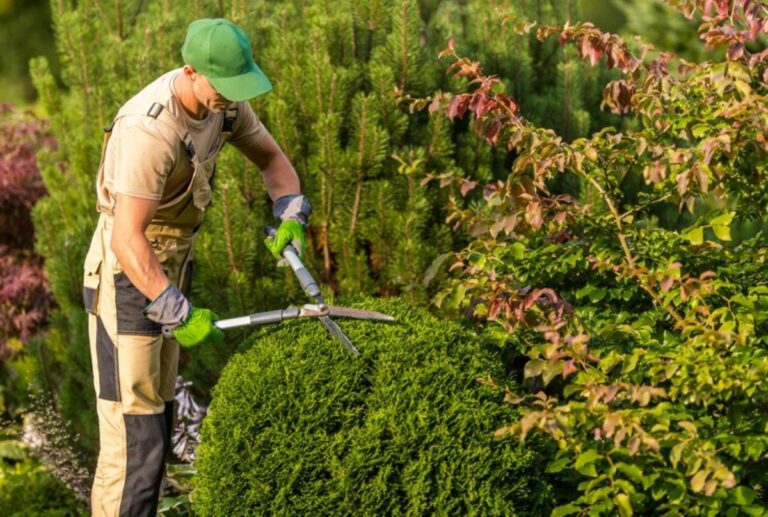In the realm of landscaping, hedges serve not just as functional boundaries but also as elements of aesthetic beauty and design. Professional hedge trimming services can help elevate the appearance of your garden by ensuring that your hedges maintain their form and health throughout the year. Understanding the importance of this service can lead you to a stunning environment that enhances your property’s overall appeal.
Understanding the Importance of Professional Hedge Trimming
Hedge trimming is more than just a seasonal chore—it’s an essential aspect of maintaining the health and appearance of your landscape. While it might seem straightforward, achieving the perfect shape and size requires knowledge and expertise.
The Art and Science Behind Hedge Trimming
At first glance, hedge trimming may appear as though it is solely an artistic endeavor, but it involves a significant amount of science. Each variety of hedge plant has specific growth patterns and requirements that necessitate particular trimming approaches.
The art lies in the aesthetic shaping of the hedges, ensuring they complement the surrounding landscape and architectural features of the property. The science focuses on timing and techniques that promote healthy growth while preventing disease. Understanding these aspects helps in making informed decisions about when and how to trim hedges effectively.
Moreover, the seasonal changes play a crucial role in determining the best times for trimming. For instance, many hedges benefit from a trim in late winter or early spring before new growth begins, while others may require a mid-summer trim to maintain their shape. Additionally, knowledge of local climate conditions can influence trimming schedules, ensuring that the plants are not stressed during extreme weather. This blend of artistic vision and scientific understanding is what sets professional hedge trimmers apart from amateur efforts.
Why Choose Professional Services Over DIY?
While many homeowners may consider tackling hedge trimming themselves, hiring professionals offers numerous advantages. Professional landscapers have the tools, skills, and knowledge to achieve not only the best shapes but also maintain the health of your plants.
- Expertise: Professionals are trained to understand the different types of hedges and their care requirements.
- Safety: With the use of specific tools, professionals reduce the risk of personal injury and accidents that can occur during DIY trimming.
- Time-Efficiency: Hiring professionals ensures the task is completed efficiently, freeing up your time for other important matters.
In addition to these benefits, professional services often include a comprehensive assessment of your landscape. They can identify potential issues such as pest infestations or diseases that may not be immediately visible to the untrained eye. This proactive approach not only enhances the beauty of your hedges but also contributes to the overall health of your garden. Furthermore, many professional services offer ongoing maintenance plans, ensuring that your hedges remain in pristine condition throughout the year, adapting to seasonal changes and growth patterns with expert care.
Key Factors to Consider When Trimming Hedges
When it comes to hedge trimming, various factors come into play that can affect the outcome. Paying attention to these details can lead to better results and a healthier garden overall.
Hedge Type and Ideal Shape
Different types of hedges require different trimming techniques and shapes. For example, evergreens may be shaped into formal structures, while flowering hedges might be trimmed to encourage blooming. Understanding the specific types of hedges you have will guide you to the appropriate trimming style.
Before trimming, it’s crucial to determine the desired shape—whether it’s rounded, square, or a natural form—while considering how the hedge interacts with seasonal changes and other plants in your garden. Additionally, the height of the hedge plays a significant role in its overall appearance and functionality. A taller hedge can provide privacy and windbreaks, while a lower hedge may serve as a decorative border or define garden pathways. Each shape and height can dramatically alter the aesthetic of your outdoor space, making it essential to plan accordingly.

Seasonal Timing for Trimming
Timing is critical when it comes to hedge trimming. The best time to trim varies depending on the species and the desired outcome. Generally, late winter to early spring is ideal for many types of hedges since this timing encourages vigorous growth as temperatures rise.
However, it’s essential to monitor your specific plants’ growth patterns and flower cycles. Some hedges may prefer trimming after flowering to ensure blooms in the next season. Properly timed trimming promotes not only aesthetic benefits but also healthy regrowth. Moreover, understanding local climate conditions can also influence your trimming schedule. For instance, in regions with milder winters, some hedges may benefit from an earlier trim, while those in harsher climates might need to wait until the risk of frost has passed. This attention to detail can help ensure that your hedges thrive throughout the seasons.
Safety Measures in Hedge Trimming
Safety should always be a priority, whether you are undertaking a DIY approach or hiring professionals. Using proper equipment and adhering to safety protocols reduces the likelihood of accidents.
- Dress Appropriately: Wear gloves, goggles, and protective clothing to prevent injuries.
- Use Sharp Tools: Dull cutters can cause uneven cuts and injury; ensure tools are well-maintained.
- Be Aware of Your Surroundings: Avoid overhead power lines and unstable footing.
In addition to these precautions, it’s wise to have a first aid kit on hand, just in case of minor injuries. If you’re using power tools, familiarize yourself with their operation and safety features before starting your project. Taking the time to prepare can make a significant difference in ensuring a smooth and safe trimming experience. Furthermore, if you are working on larger hedges, consider enlisting a partner to help, as having an extra set of hands can improve safety and efficiency while allowing for a more thorough job.
The Process of Professional Hedge Trimming
Engaging a professional service for hedge trimming involves several critical steps that ensure successful results. Understanding this process can help ease any concerns you may have about the service.
Initial Consultation and Hedge Assessment
The first step in professional hedge trimming usually includes an initial consultation. This is when professionals assess the hedges to determine their health and the extent of trimming required.
During this assessment, they’ll evaluate the hedge type, size, and any potential issues such as pests or disease. This detailed approach ensures that the trimming carried out will not only improve aesthetics but also promote the longevity and health of the plants. Additionally, professionals may discuss the client’s vision for the landscape, offering insights on how different trimming styles can enhance the overall appearance of the property. This collaborative dialogue lays the groundwork for a tailored service that meets both practical and aesthetic needs.
Trimming and Shaping Techniques
Once the assessment is complete, the actual trimming process begins. Professional landscapers employ various techniques to ensure that each hedge is aesthetically pleasing and shaped according to the client’s desires.
Using tools like hand shears, hedge trimmers, and sometimes even drones for larger properties, they are able to achieve precision cuts that would be difficult for an amateur. Moreover, experienced professionals know exactly how to trim without damaging the plants, keeping their health a top priority. They often take into account the natural growth patterns of the hedge species, ensuring that the final shape complements the plant’s inherent structure. This knowledge not only enhances the visual appeal but also fosters healthy growth, allowing the hedges to flourish in the long term.
Post-Trimming Care and Maintenance
After the trimming is done, it’s essential to care for the hedges to help them recover and thrive. Professionals often provide guidance on how to maintain the hedges post-trim, whether through watering, fertilization, or pest control measures.
Regular checks and care can prevent future issues and ensure that the newly trimmed hedges remain healthy and aesthetically pleasing throughout different seasons. Additionally, many professional services offer ongoing maintenance packages, allowing homeowners to schedule regular visits for pruning, shaping, and health assessments. This proactive approach not only saves time but also ensures that the hedges remain in prime condition, adapting to seasonal changes and potential environmental stressors. By investing in professional hedge trimming and maintenance, homeowners can enjoy a vibrant landscape that enhances their property’s curb appeal and overall value.
Benefits of Regular Professional Hedge Trimming
Investing in professional hedge trimming offers various benefits that contribute to the beauty and health of your landscape.
Enhancing Curb Appeal
Well-trimmed hedges vastly improve your property’s curb appeal. Whether you are looking to sell your home or simply enhance your outdoor space, a neat and tidy hedge can make a significant difference in first impressions.
Regular trimming helps maintain a polished look that draws attention and admiration from passersby, enhancing the overall aesthetic value of your property. This is particularly important in neighborhoods where homes are closely situated, as the visual appeal of your landscaping can set your home apart from others. A well-defined hedge can act as a natural frame for your home, highlighting its architectural features and creating a welcoming atmosphere that invites guests and potential buyers alike.

Promoting Plant Health
Regular professional trimming plays an essential role in the overall health of your plants. By removing dead or diseased branches, trimming encourages proper airflow and sunlight penetration, which are crucial for healthy growth.
A healthy hedge is more resistant to pests and diseases, reducing the need for chemical treatments and promoting a more sustainable garden environment. Furthermore, professional trimmers possess the expertise to identify potential issues before they escalate, such as signs of disease or pest infestations, allowing for timely interventions. This proactive approach not only ensures the longevity of your hedges but also fosters a vibrant ecosystem that supports local wildlife, including beneficial insects and birds that contribute to a balanced garden.
Increasing Property Value
Investing in landscaping beautifies your property and can lead to an increase in property value. Well-maintained hedges contribute to the overall health and aesthetics of your landscape, making your home more appealing to potential buyers.
A professional hedge trimming service is not merely a chore—it’s a valuable investment that pays dividends in beauty, health, and property value, showcasing the true potential of your outdoor space. In addition to enhancing visual appeal, well-kept hedges can create functional outdoor spaces, such as natural privacy screens or windbreaks, which are attractive features for buyers looking for comfort and seclusion in their outdoor living areas. Moreover, a well-landscaped property often reflects a homeowner’s commitment to maintenance and care, further reassuring potential buyers about the overall condition of the home itself.
Related : Hedge Trimming Service Near Me: How to Find the Best for your needs

